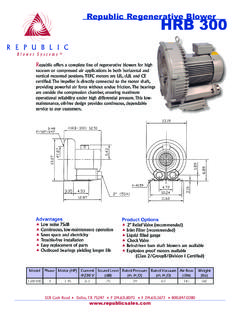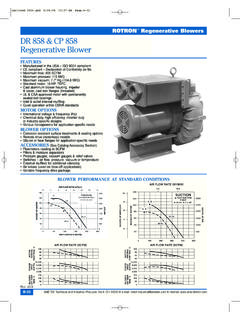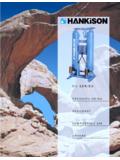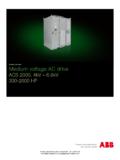Transcription of Fossil Fuel Fired Boiler Air and Gas Path
1 UNESCO EOLSSSAMPLE CHAPTERSTHERMAL POWER PLANTS Vol. II - Fossil fuel Fired Boiler Air and Gas Path - Chaplin Encyclopedia of Life Support Systems (EOLSS) Fossil fuel Fired Boiler AIR AND GAS PATH Chaplin University of New Brunswick, Canada Keywords: combustion, air, flue gas, fans, air heaters, sootblowers Contents 1. General Principles Combustion Requirements Primary and Secondary Air Air Ducting Arrangement 2. Fan Characteristics System Fans Forced Draught Fans Primary Air Fans Induced Draught Fans Gas Recirculating Fans Fan Design Radial Flow Fans Axial Flow Fans System Curves Operational Conditions Series and Parallel Arrangements Parallel Arrangement Series Arrangement Fan Operation Furnace Explosions Furnace Implosions No Change in Control Dampers Fast Response of Induced Draught Dampers Fast Response of Forced Draught Dampers 3. Air Heaters General Recuperative Air Heaters Tubular Air Heaters Plate Air Heaters Heat Pipe Air Heaters Regenerative Air Heaters Ljungstrom-type Rothemuhle-Type Exhaust Temperature Control Recirculation Bypassing Preheating 4.
2 Sootblowers Ash and Slag UNESCO EOLSSSAMPLE CHAPTERSTHERMAL POWER PLANTS Vol. II - Fossil fuel Fired Boiler Air and Gas Path - Chaplin Encyclopedia of Life Support Systems (EOLSS) Sootblowing Media Sootblower Types Short Retractable Furnace Wall Blowers Long Retractable Convection Surface Blowers Non-retractable Air Heater Blowers 5. Gas Cleanup Facilities Particulate Collection Electrostatic Precipitators Fabric Filters Gaseous Product Collection Desulphurization Equipment Nitrogen Oxide Removal Equipment Future Trends Acknowledgments Glossary Bibliography Biographical Sketch Summary Air is required when burning any Fossil fuel . For coal, the ratio by weight of air to fuel is about 12. For a high heat release rate, therefore, a vast amount of air must be supplied and even more exhaust gas removed. Forced draught and induced draught fans drive the flows. These fans, located in the inlet and outlet ducts respectively, operate together to maintain balanced draught conditions in the furnace.
3 This ensures that the furnace operates under a slight vacuum to prevent the egress of combustion products. Air heaters in the system are arranged so that excess heat in the exhaust gas is transferred to the inlet air thus enhancing the thermal efficiency of the steam-generating unit. In coal- Fired plants, some of the heated air is directed to the coal pulverizers, via primary air fans, to pick up the pulverized fuel and carry it into the furnace. Here the fuel -rich primary air is mixed with sufficient secondary air, coming directly from the air heater, to give the proper air fuel ratio for good combustion. Boilers must be protected from implosions arising from the sudden loss of ignition in the furnace and from explosions due to subsequent sudden ignition of clouds of suspended fuel particles. Proper operation of the fans can ensure protection during a flameout, and adequate purging of the gas ducts can prevent uncontrolled ignition of unburned fuel .
4 The furnace walls and convection passes are kept relatively clean and free from heavy ash deposits by frequent sootblowing. Sootblowers utilize a high-pressure jet of steam or air, and sometimes even water, to remove ash deposits from the gas path. This is essential in maintaining the proper balance between the heat absorbed by the furnace walls and in the convective passes. In order to ensure that the exhaust gas is discharged in as clean a condition and as pollutant free as possible, provision is made to trap fly ash and to remove sulfur dioxide UNESCO EOLSSSAMPLE CHAPTERSTHERMAL POWER PLANTS Vol. II - Fossil fuel Fired Boiler Air and Gas Path - Chaplin Encyclopedia of Life Support Systems (EOLSS) and nitrogen oxides if necessary. Particulate matter may be removed very efficiently by means of electrostatic precipitators or fabric filters. The removal of sulfur dioxide, if produced, requires scrubbing in a desulphurization unit.
5 Nitrogen oxides may be reduced during the combustion process but catalytic reducers can effect an additional reduction after leaving the furnace. 1. General Principles Combustion Requirements The burning of any hydrocarbon fuel requires oxygen from the atmosphere in sufficient quantity to ensure proper combustion. Since atmospheric air is a mixture of oxygen and nitrogen, a considerable amount of nitrogen must be handled to provide sufficient oxygen. Furthermore, excess air is usually provided to ensure complete combustion of the fuel under imperfect mixing conditions. The net result is that, in large steam-generating units, vast amounts of combustion air must be provided to the furnace and even greater amounts of exhaust gases removed. For coal, an air fuel ratio of 11:1 to 12:1 is required. For oil this is somewhat higher. A typical coal- Fired power plant with an electrical output of 500 MW requires about 50 kg s 1 of coal and about 550 kg s 1 of air to produce about 600 kg s 1 of exhaust gas.
6 This, translated into volumetric air and gas volume flow rates at the inlet and outlet, gives about 500 m3 s 1 and 675 m3 s 1 respectively. To handle these flows very large ducts and fans are required and a considerable amount of energy is expended in maintaining these flows. Air and fuel are supplied to the furnace and hot exhaust gases removed from it. The furnace itself must operate at a pressure very slightly below atmospheric pressure so that exhaust gases do not blow out through various inspection and access openings when they are not closed. However, it should not operate at too low a pressure otherwise excessive cold air will be sucked into the furnace. In order to achieve this balanced condition, all large steam-generating units have separate fans supplying combustion air to the furnace and removing exhaust gases from it.
7 The air and gas path of a typical coal- Fired Boiler plant is illustrated in Figure 1. The fans providing the air are forced draught fans and those removing the exhaust are induced draught fans. The flow through them is controlled by moving the control dampers or by varying the fan speed. Between the forced draught and induced draft fans there is a progressive decrease in pressure through the system with the pressure in the furnace maintained at the desired slightly sub-atmospheric condition. The stack, which is downstream of the induced draught fan, provides some assistance to the flow because of the buoyancy effect of the hot exhaust gas over its height but this effect is relatively small compared with the driving effect of the fans. UNESCO EOLSSSAMPLE CHAPTERSTHERMAL POWER PLANTS Vol. II - Fossil fuel Fired Boiler Air and Gas Path - Chaplin Encyclopedia of Life Support Systems (EOLSS) Figure 1.
8 Air and gas path in a coal- Fired Boiler plant Primary and Secondary Air The combustion air supplied to the furnace is divided into separate primary and secondary air streams. This arrangement promotes rapid ignition of the fuel in a rich fuel air primary stream and complete combustion in a plentiful supply of secondary air. Refinements to this arrangement allow for the reduction of flame temperatures and some control of nitrogen oxide emissions. In a coal- Fired Boiler , the primary air stream also serves to transport the pulverized fuel to the burners. This requires separate ducting and primary air fans to convey the primary air through the pulverizers. In oil and gas- Fired boilers the primary air is only separated from the secondary air at the burners. In coal- Fired boilers the required air coal ratio of the mixture leaving the pulverizers ranges from :1 to about :1 and is generally near 2:1 for vertical spindle mills.
9 Thus the amount of primary air is relatively low compared with the amount of secondary air to give the required combustion air fuel ratio of 11:1 to 12:1. The power requirements of primary air fans are, however, quite high because of the large friction pressure drops arising due to the high air velocities required to separate and transport the pulverized coal. Air Ducting Arrangement The air inlet for the steam-generating unit is nearly always near the top of the Boiler where hot air accumulates inside the Boiler house. Temperatures here are often 30 C to 40 C and higher, thus providing some initial air preheating derived from thermal loss UNESCO EOLSSSAMPLE CHAPTERSTHERMAL POWER PLANTS Vol. II - Fossil fuel Fired Boiler Air and Gas Path - Chaplin Encyclopedia of Life Support Systems (EOLSS) through the Boiler walls. The air is drawn in by a pair of forced draught fans that deliver the air to the air heaters for preheating.
10 On leaving the air heaters, the hot air is directed to the air inlet plenum surrounding the burners on the sides or corners of the furnace. In the case of coal- Fired boilers, primary air is separated from the secondary air just after the air heaters and directed to the pulverizers. This is tempered, if necessary to avoid too high a temperature in the pulverizer, by mixing with a small amount of cold air taken off the main stream just before the air heaters. There may also be an air bypass around the air heater to reduce the amount of heat absorbed by the air in order to maintain the exhaust gas temperatures. Alternatively, hot air recirculation from the heater outlet back to the forced draught fan inlet may be employed to maintain the exhaust gas temperatures. If the exhaust gas temperatures are too low, condensation may occur in the gas ducting thus leading to corrosion.

















